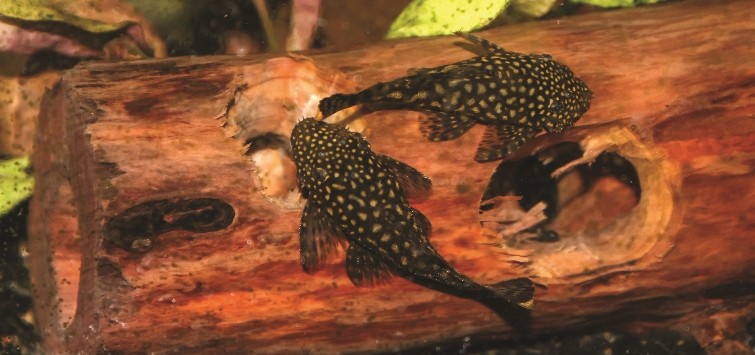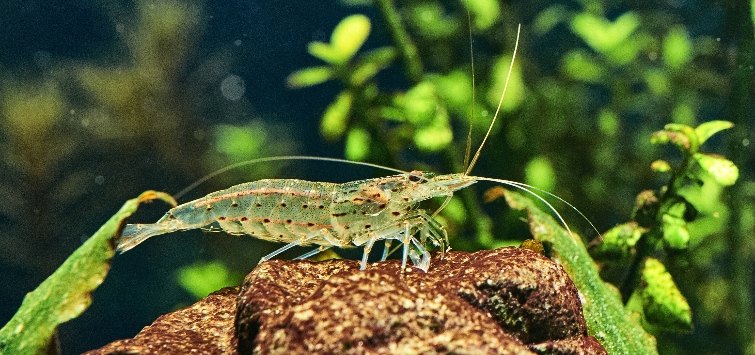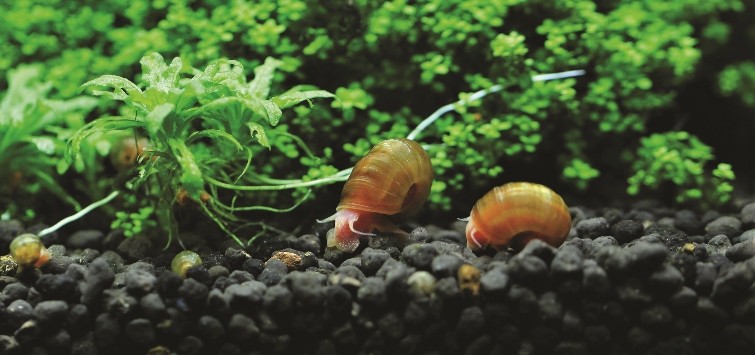Freshwater Algae Eaters for the Nano Tank
Author: Joshua Wiegert
When I first started keeping an aquarium, I was told that every single tank needed to have an algae eater and a bottom feeder in it, and I was promptly sold a Chinese algae eater and a single cory cat. This was bad advice then, and it continues to be bad advice today. The species used have changed, with the Chinese algae eater having effectively vanished from the hobby, but the idea that throwing a cleaner or two into your tank will relieve you of cleanup duties—and only need to eat whatever they can find laying around—stubbornly persists.
Like most bad advice that gets bandied about for years, there’s enough of a kernel of truth in it for it to persist. Algae-eating fish and inverts are a wonderful addition to the aquarium, and they can indeed help reduce maintenance. They are not required, however, nor will they entirely negate the need for taking care of the tank; they will only reduce how much needs to be done. And most algae-eating animals cannot subsist solely on what they can scrounge up in the tank, but rather require their own special care, including appropriate feedings.
Cleaners in the Nano Tank
Many of the freshwater algae eaters commonly traded in the hobby simply don’t work for a nano aquarium. They either get too big for smaller tanks or require more swimming room than we can offer them. Even really good algae eaters, such as the so-called “Siamese” algae eaters, fail to work in smaller tanks. So, what are some better choices?
Let’s set up some criteria for picking a good nano algae eater first; the fact that an algae eater doesn’t have to be a fish, which opens up lots of possibilities. Obviously, any algae eater has to help remove problem algae, and it should stay small and not need more swimming room than a smaller tank can provide.
Outstanding Oto Cats
The first fish that spring to mind are those miniature wannabe plecos, the oto cats. Primarily members of the genus Otocinclus, from which their common name derives, there are a lot of different species in the hobby.
Nominally, the most common is the golden otocinclus, which has been moved to its own genus, Macrotocinclus affinis. It should be noted that while this scientific name (typically in the old genus) is the most commonly applied, most oto cats in the trade aren’t actually M. affinis, a seldom imported species. What you’ll buy as “oto” cats are a mixed bag of about a half-dozen other species, and more than one type may be present in a batch. My personal favorite is (naturally, as a DC Comics fan) Otocinclus batmani, which I’ve only ever been able to find once in an oto cat shipment.
Otos are fairly similar in appearance to a stereotypical pleco and function much like them, with two big differences (aside from their size): Unlike most of the familiar loricariids, otos are shoaling fish that live in big groups in the wild, often mixing with shoals of cory cats. Indeed, several species of otos are thought to be Batesian mimics of Corydoras species. As such, they shouldn’t be kept as single fish, ever. They’re also diurnal (active during the daytime), which sets them far apart from most of their catfish cousins.
Otos are fantastic little freshwater algae eaters that can make short work of many types of film algae in an aquarium. They’re gentle on plants, eating algae from their leaves without doing significant damage, which is not often the case. They’re my go-to for most small tanks, especially planted ones. But they’re not without their problems.
Probably the biggest negative with oto cats is that it is really hard to get healthy ones. Otos need to eat regularly, and they’re often rather starved by the time they get to us, although it’s hard to tell. They don’t recover well from this, and hobbyists who expect them to eat nothing but algae tend to find that they starve to death in their tanks—or, rather, just “mysteriously” die. They need regular feedings of algae-based foods to thrive.
Perfect Plecos

For the larger nanos and for aquarists looking for a more traditional pleco, two groups of plecos can’t be beat. The common bushynose, a likely hybrid domesticated fish of the genus Ancistrus, and the rubberlip plecos, members of the genus Chaetostoma, are both reasonably small and good nano algae eaters. I rate the rubberlips as a better algae eater than the bushynose, but they’re quite a bit more delicate (and aren’t bred in aquariums very often).
Rubberlips live in fast-flowing water in the wild and are sensitive to low oxygen levels, meaning they may not be a good choice for heavily planted tanks, or overly stocked ones. They’re wild-collected, and, unfortunately, have a very low success rate. Many die in collecting buckets before reaching us due to their oxygen needs. They do have a huge advantage over the bushynoses, though, in that they don’t demolish driftwood and are much less prone to leaving behind piles of “pleco poop.”
Great Gobies
One of the more interesting groups of fish that seldom get used for algae-eating purposes are the gobies. There are tons of relatively new freshwater goby species in the trade, though they all seem to get traded under the name elegant goby, Stiphodon sp., or some variation. I suspect that they’re a mixed bag of several species, and many of them are fantastic algae eaters. They’re also incredibly gorgeous fish.Though much harder to find, members of the genus Sicydium are known as algae gobies for a reason. Most are found in flowing streams entering the Caribbean and Western Atlantic, which are not areas known for heavy fish collecting. I’ve found some myself in the wild in Puerto Rico, but, as it’s very difficult to remove animals from the island, I didn’t collect any.
Some gobies are reported to eat cyanobacteria in the aquarium, but it’s tough to know which species, or even genus, is involved because we seem to just trade them all under a handful of names.
Other Fish Options
We also shouldn’t neglect some of the less typical options for our nano tanks. I have written before, and still maintain, that one of the best algae-eating fish in the world is the rosy barb. They’re not going to scrape that brown diatom coating from your front glass, but they’ll pull every bit of algae off your plants, especially filament and hair algae. And, as if that’s not enough, they’ll destroy the second-biggest pest in the aquarium (after Java moss), duckweed, all while leaving your desirable plants alone.A lot of other barb species also eat algae. So do many of our livebearers, such as Ameca splendens, the butterfly goodeid, a livebearer renowned for its ability and willingness to eat pest algae in the aquarium. Unfortunately, they’re big and rowdy, so they’re not for nano tanks, but their proclivities are shared by many other livebearers.
Even the humble platy will graze on algae, and some of its wild Xiphophorus cousins will as well. I’ve watched the tiny little pygmy swordtail (X. pygmaeus) tear bits of algae from plants and rockwork; in fact, some experts argue that they require algae in their diet for long-term success.
Super Little Shrimps

Of course, we can’t ignore our invertebrate friends that eat algae, either. I don’t know that the planted hobby would exist in its current form without the Amano shrimp. These little shrimp were brought to the attention of the hobby by the revered nature photographer and founder of the Nature Aquarium, Takashi Amano.
They’re renowned for their constant algae grazing, plucking tiny bits of algae from plants, between rocks, and on driftwood. I’ve seen them climb up the glass and pluck algae as well, but to think they would thoroughly and reliably clean your tank glass is more than a stretch.
While they’re not as efficient as the Amano shrimp, many other species of shrimp will also eat algae, including the basic cherry and crystal shrimps. TFH contributor Steve Waldron reported on a planted tank he helped set up at the Seattle headquarters of Amazon.com that was essentially “the world’s largest shrimp bowl,” where hordes of cherry shrimp swarmed and groomed plants nonstop.
All Hail the Snails

Nerite snails are typically used in planted tanks. Aside from not reproducing in freshwater, they also tend not to bother plants. But while they don’t successfully reproduce, they do try, leaving little egg sacs all over the tank. I personally find these egg sacs to be unsightly and something of a nuisance, particularly as I’ve hit one with an algae magnet, dragged it over the glass, and left a scratch.
There exists an enormous variety of species and types of nerites, so perhaps I’ll eventually find one that doesn’t lay so many eggs, though my wallet is fond of the basic, inexpensive olive nerite. I do also love the look of the beautiful horned nerite, a smaller species that is perfect as a nano algae eater.
Mystery snails have waned in popularity among aquarists for a variety of reasons. They’re technically just apple snails, which get sizeable given time, and have become invasive in lots of different regions. They’re also linked to some nasty diseases. And while they’re good at eating algae, they also eat…well, everything else, including all your desirable plants.
I’ve seen some aquarists put mystery snails in planted tanks with mixed results, but I wouldn’t do it. That having been said, they’re still available, and some of the color morphs of their shells are just stunning.
One of the things I’m most perplexed by, though, is aquarists who go to extreme efforts to eradicate their tanks of the pest snails that often hitchhike in on plants. I even find the term “pest snail” confusing—”free snail” has a much better ring to it and is a much better description.
The little ramshorn snails, bladder snails, and even Malaysian trumpet snails are all great algae eaters, and I never discourage them in my tanks. Their numbers only seem to reach plague proportions when there’s another problem going on in the tank. For example, if you overfeed, you’re going to grow a huge population of trumpet snails in your gravel bed, and that’s going to cause some issues.
I’m especially unbothered by the little ramshorn snails. They’ll cruise the glass, rocks, decorations, and even plants nonstop, gobbling down algae. And they will reproduce in sufficient numbers to help keep algae levels down. They can, and will, become a problem if your tank has other problems, but in a well-maintained aquarium that is not overstocked, not overfed, gets regular water changes, etc., I don’t ever find them to become pests. And they look pretty cool!
It All Comes Down to You
Your best algae control method, in a nano tank or any other kind, is always going to be a good algae scraper. We should never expect our livestock to be the sole defense. However, it’s great to have their help in keeping the glass, rocks, and even plants clear between maintenance days. There are a lot of great fish and other animals that can assist us as freshwater algae eaters, and many are suitable for even the smallest of nano tanks.

.png?h=595&iar=0&w=2781&hash=5FD5E69473BCC22199FBFA2FB71B6033)



